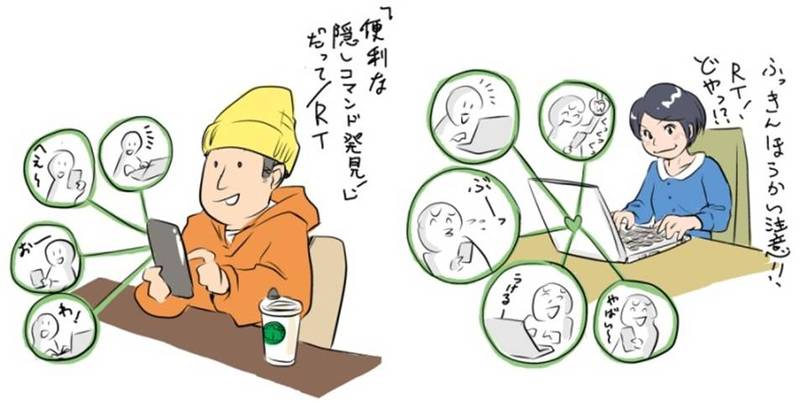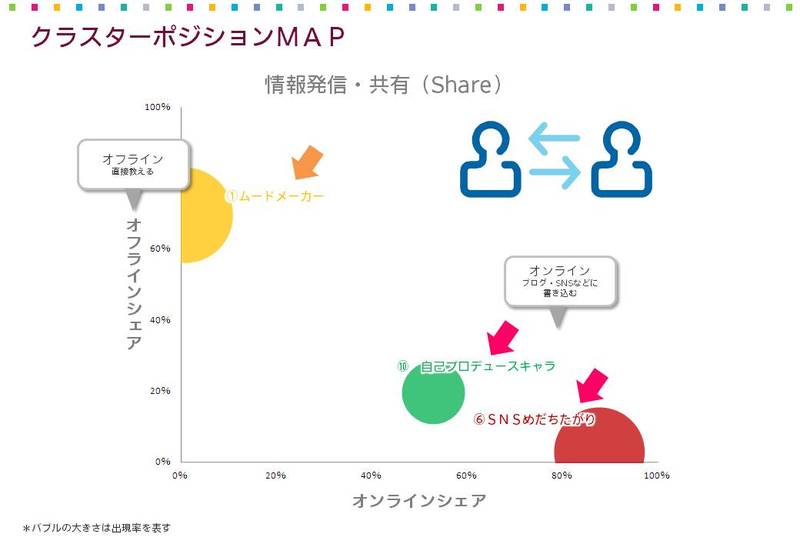Last time, we introduced the overall picture of the 10 clusters jointly analyzed and created by Dentsu Wakamon and DENTSU SOKEN INC. Media Innovation Research Department. This time, we delve deeper into two distinctive types from among them.
The "SNS Show-Offs" Who Want to Summarize and Share (9.1% of the total)
This type is a mini-curator who genuinely enjoys sharing information. They possess strong information processing skills, excel at gathering information scattered across the web and sharing it with others, and have a strong desire for knowledge and recognition from others. They exhibit high SNS usage rates, utilization levels, and both follower counts and following counts. They constantly seek out topics in their real lives but tend to act more like an "editor" who shares information without adding much personal opinion or commentary.
While the spread of SNS has made sharing information easy, when interviewing young people, responses like "I learned about yesterday's topic on a curation site" or "I saw a friend retweet (RT) it on Twitter and learned about XX" are common.

SNS attention-seekers
This type highlights young people who act as mini-curators, "compiling articles and links" or "spreading content through retweets and shares." The "mini" prefix is significant because these kids aren't engaging in deep curation (editing) – they're curating with a single click of a retweet or share button.
Why "mini" curation? The underlying mindset is a desire to be well-regarded by others and to stand out. But when they throw information found online onto social media, they don't post it with "their own opinion"; they share it as-is to stage themselves as "the person who knows this info (look at me!)".
While they have desires like "wanting to be the first to mention something new or interesting" or "wanting a little sense of superiority," they are also "reading the room" on SNS. Data strongly indicates this awareness of "being careful not to stand out from others," and in subsequent group interviews, comments emerged like "I don't want to reveal too much of myself on SNS" and "I only write things that won't upset others."
Influenced by SNS, young people today engage with more communities. Amidst this, they want to stand out and be noticed, but also fear being seen as awkward or revealing too much. The result is likely a mindset and behavior of skillfully riding popular online trends and information to craft their persona.
"Self-Produced Characters" Betting on the Internet (4.4% of respondents)

Self-Produced Characters
On the other hand, there's the "Self-Produced Character" type who actively promotes "themselves."
They are the type who want to become famous using their real names, harboring so-called "alpha blogger" aspirations, and constantly act with self-branding in mind. They have diverse interests and strong ambitions for challenge and upward mobility. The most distinctive feature is that many of them have their own means of expression, such as personal blogs or websites. They actively post and write from their computers or smartphones, sharing their own opinions there. This type also shares the common trait of being very concerned about the reactions of those around them.
However, since "themselves" are central to their content, data strongly shows traits like "enjoying posting daily life online to share with friends/acquaintances" and "finding it fun to connect with strangers through media." This reveals a strong desire for distinct personal branding and communication. This contrasts with the slightly nuanced mindset of the earlier "SNS attention-seekers."
Comments from group interviews also revealed a conscious effort to maximize the impact of their posts: "When writing blog posts, I want to look good, so I avoid emojis and use formal language," and "Photos of just food get little reaction, so I post pictures of myself eating on Twitter and Facebook."
"Online Megaphone" and "Offline Megaphone"
Incidentally, there are two reasons we focused on "SNS attention seekers" and "self-produced characters" this time. First, they are types born precisely because of the widespread adoption of SNS as a tool for information dissemination and sharing. Second, when considering communication strategies, they can potentially become dissemination devices online.
If spreading topics and amplifying them is likened to a megaphone, the "mood makers" introduced last time spread topics through real experiences and real communication, making them an [Offline Megaphone]. The "SNS attention seekers" and "self-produced characters" introduced this time, who curate and post online, have the characteristic of being an [Online Megaphone].
To capture young people's interest, get them talking about your brand, and have them spread the word, understanding your target audience is essential. Just looking at the communication characteristics of these three types alone, you can see they are distinctly different.

The "Mood Makers" share directly, while the "SNS Show-offs" and "Self-Produced Characters" share online.
Well, we've now covered "Understanding Youth Clusters Through Media Communication" in two parts.
Each type has vastly different triggers, interests, communication styles, and consumption habits. For the "SNS Show-Offs" we introduced this time, their triggers might be useful content or information they can share to get "likes." For the "Self-Produced Characters," their triggers likely become value standards like places, people, or things that elevate their sense of status by going there or buying them.
We hope these ten distinct youth archetypes serve as a helpful guide to understanding today's young people and building happy relationships.
Which type of young person do you see around you?
(Column: Makoto Ogi / Illustration: Yosuke Kojima)
〈Analysis Overview〉
Factor analysis and cluster analysis were performed using d-camp data.
Data Used: d-camp2012 (Survey Period: October 2012 - July 2013)
Survey Area: Kanto region (Tokyo and 6 prefectures)
Analysis Subjects: Males and females aged 15 to 29 (excluding junior high school students) (1163 subjects)
Survey Method: Mail-in questionnaire
Survey Implementation Agency: Dentsu Macromill Insight, Inc.

【Wakamon Profile】
Dentsu Inc. Youth Research Department (commonly known as Wakamon) is a planning team that engages with the real lives and mindsets of young people, primarily high school and university students. By understanding their "present," we seek hints to brighten and invigorate the near future. We foresee the future based on their insights and realize new businesses that foster better relationships between young people and society. Currently, 14 project members are based across the Tokyo headquarters, Kansai branch, and Chubu branch. Information is also shared on the Wakamon Facebook page ( https://www.facebook.com/wakamon.dentsu ).







